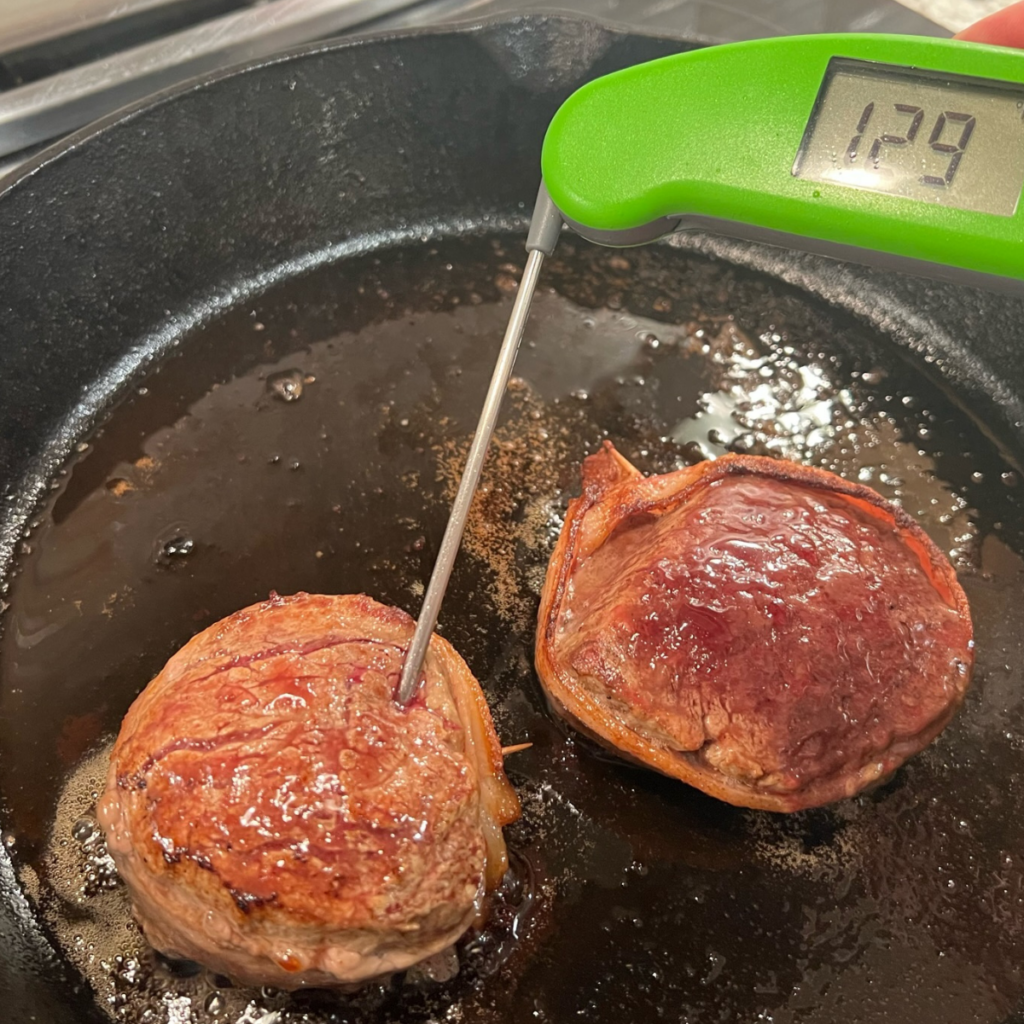A good meat thermometer will improve how you cook beef more than any other kitchen tool. It’s a must have in any kitchen. However, you have to use it correctly in order to get the best results. Here’s how to use a meat thermometer.

We once heard that cooking beef without a good thermometer is like driving a car without a speedometer, and we couldn’t agree more. A good meat thermometer will improve how you cook beef more than any other kitchen tool. It’s a must have in any kitchen.
In case you’re thinking, but what about DIY touch-test methods to check for doneness? Yes, we know they’re out there and we’ve talked about them before. However, a thermometer is the only way to guarantee that your beef is done to the appropriate temperature. In our kitchen, we always test our beef with a thermometer and we recommend that you do the same.
What to look for in a digital meat thermometer:
Meat thermometers have numerous features, but there are three that are must-haves that we always look for.
- Is it digital? There are two common types of handheld thermometers – digital and dial face. Go with digital. They’re easy to read and they register temperatures faster. Ideally, your thermometer should be able to read the temperature in 5 seconds or less. Why that fast? Because a few extra minutes on the grill is the difference between serving a medium steak or well-done steak.
It’s also important to keep in mind that when cooking beef, the temperature will continue to rise after being removed from the heat. This is called carry-over cooking, and is why professional chefs recommend removing the beef from heat when it’s 5-10 degrees below the serving temperature. - Does it have a long probe? You want a probe that’s at least 4 inches long so that it can reach the center of a larger roast.
- Is it splash proof and/or water resistant? We’re messy cooks. Water-resistant thermometers are easier to clean and are less likely to be damaged while cooking.
How to use a digital meat thermometer:
Taking a steak’s temperature is easy with an instant-read meat thermometer (here’s our favorite). The beauty of most meat thermometers is that they’re extremely easy to use out of the box. You probably won’t need to read directions. However, the key to an accurate reading and knowing the internal temperature of the steak is to place the thermometer in the correct location in the beef, and that’s up to you.
Here are a few things you must keep in mind when taking the temperature of your steak:
- Location. Location. Location. When taking steak temps, measure in the thickest part of the steak or the center of the beef, not touching bone or fat. For steaks 1/2 inch or thicker, it’s usually best to insert an instant-read thermometer horizontally from the side.
- Remember carryover cooking. When you take a temperature reading of steak, you’re not always looking for the specific number in the chart above. Rather, you want to pull your steaks off when the thermometer reads 5-10°F lower than the desired doneness. In general, thicker cuts, like a rib eye steak or porterhouse steak, retain heat longer and need a longer resting time. Also, steaks cooked at high heat on a grill or a cast-iron skillet typically need longer resting time compared to steaks cooked at lower heat.
Checking a thermometer for accuracy and calibrating:
Our all-time-favorite thermometer is extremely accurate out of the box and we’ve never had to calibrate it or check it for accuracy. If you’re using a thermometer you don’t trust, this information may be helpful, but please know we have never used either method.
There are two ways to check the digital meat thermometer’s accuracy: ice water and boiling water.
For the ice water method, fill a large glass with ice. Then, add cold water to the glass and stir the ice mixture. Immerse at least 2-inches of the thermometer’s probe into the water and wait 30 seconds before reading. Make sure the probe doesn’t rest against a chunk of ice while taking the reading or it could read inaccurately. The final reading should be 32 °F.
The boiling water method is a little trickier and it should only be used if the ice bath test result is conclusive. For the boiling water method, put at least 4-inches of water into a pot and bring it to a full, rolling boil. Immerse at least 2-inches of the thermometer’s probe into the water and wait 30 seconds before reading. Make sure the probe doesn’t come in contact with the pot or it could show a higher temperature. Here’s the tricky part — the boiling point of water changes based on elevation, so you need to take into account where you live to know the temperature water usually boils at. The final reading should be 212°F if you’re at sea level.
Beef Temperature Chart
Here’s the only chart you’ll ever need for steak temperature. As you’ll see, we’ve included a color and touch description, but we really didn’t want to! We’ve done it since it’s what so many people are accustomed to seeing. However, please use the temperatures, not the visual description!
Also, it’s critical to note that you need to pull your steak about 5-10 degrees BEFORE these final temperatures are reached.
So, if you’re wondering, why didn’t we publish a pull-temp chart, that’s a great question. Unfortunately, we can’t help you with a pull-temp chart. The reason for this is because pull-temps are extremely variable, and larger items experience more carryover than smaller.
In general, you can plan on 3–5°F of carryover for a thinner steak and anywhere from 5–10°F carryover for larger ones.
| Doneness | Temperature | Description |
| Rare | 120-129°F | Cool, bright red center; soft to the touch |
| Medium Rare | 130-134°F | Warm red center; beginning to firm up with red juices |
| Medium | 135-144°F | Warm pink center and outer portions beginning to brown; completely firm to the touch with red juices |
| Medium Well | 145-154°F | Slightly pink center; completely firm to the touch with brown juices |
| Well Done | 155-164 °F | No pink or red; firm to touch |
| Ground Beef | 160 °F | Fully brown throughout with no pink |
FAVORITE KITCHEN TOOLS:
One More Thing!
Do you want to learn more about beef? Join our weekly e-newsletter where we share farm happenings, recipes and beef availability. Sign-up and get a cheat sheet with 9-must-ask questions before buying beef directly from a farmer. Or, we have an entire ebook about beef that goes through purchasing and preparing beef from a cattle farmer’s perspective.
Here are a few other links you may like:
- Bacon Wrapped Filet Mignon
- 7 Steps to Grilling Steak to Perfection
- Easy Carne Asada Street Tacos
- Prime Rib Roast with Garlic Herb Butter
- How to choose the best cut of steak (Top 4 cuts)
- What everybody ought to know about beef cuts
This post contains affiliate links. Please see our disclosure policy for more information
We participate in the Amazon Services LLC Associates Program, an affiliate advertising program designed to provide a means for us to earn fees by linking to Amazon.com and affiliated sites. See our disclosure policy for more details

